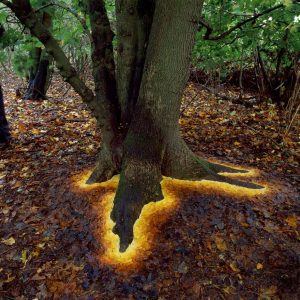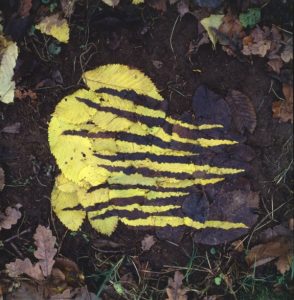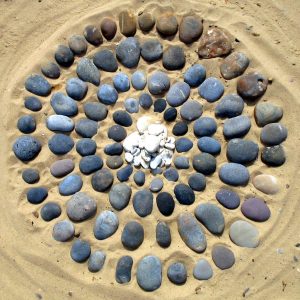Caleb Peterman- Ephemerality: The philosophy of Goldsworthy Land Art
This portfolio will feature Andy Goldsworthy’s unique style of physical art and the fleeting nature of life that It captures. Goldsworthy’s arrangements use only naturally occurring objects, such as stones, leaves, twigs, branches and the like, a unique style known as ‘Land art.’
The two themes Andy Goldsworthy’s art conveys is the finite nature of life itself and the unstoppable passage of time. The Finite nature of life is constantly portrayed by the materials in which he uses to create his works, which, by the way, are only ‘preserved’ by photographs of people who happen to witness his works. The passage of time is also conveyed, not by the content of the works themselves, but how they are meant to slowly fade away as time takes its course. Leaves will scatter in the wind or wash away in the rain, stones will erode away, and sticks will corrupt and rot. In order to allow nature to do its work, Goldsworthy uses natural materials exclusively, and makes good use of them.
I have selected 3 images to capture what Andy Goldsworthy not only stands for, but lives for. These images also perfectly display what makes his work so profoundly effective.

This image is licensed under Creative Commons Zero
The first image is that of leaves scattered around a tree to give an unnatural glow at the base of it. There is nothing being used here other than the placement of leaves, and yet it looks so smooth, so organic and cohesive that you could be forgiven for mistaking them for a glow emanating from the roots of a tree. And yet, for how painstakingly meticulously crafted this is, the only thing left of it is a single photo taken shortly after its completion. In its very conception it was doomed to disappear, and yet Goldsworthy creates it anyway. This particular work goes to show that terminality has no bearing on beauty. Experiences like this are worth ending, simply to have had it and enjoyed it while it lasted. It’s the very thing that makes life worth living: the moment. From the breathtaking events we experience perhaps once in our lives, to the daily highlights that we risk taking for granted, no moment is to small to make our time here worth the end. What better way to illustrate this concept with than such a stunning, yet short-lived artwork?

This image is licensed under Creative Commons Zero
In the particular vein of ‘no moment is too small,’ the second image is indicative of just that. Here, we have a small, quaint work. One which I believe takes elements of his ‘rain shadow’ and elements of his leaf arrangements to capture both of his themes at once. Created by preserving a part of his ‘canvas’ through various means, and letting the rest become affected by the elements for a period of time, this particular image not only emphasizes the more miniscule side of life worth experiencing, but also the relativity of the passage of time, showing an part of an object affected by change, along with a part seemingly unaffected at all, or representative of its previous state.

Beach Circle by Paul Downey is licensed under CC BY 2.0
The third image here displays an interesting aspect of not just the themes of his art, but of Goldsworthy himself. As the son of a mathematician, his use of geographical shapes in his art is evident and apparent. The precision by which he constructs these pieces, despite their ephemeral nature, is reflective of his upbringing, to the eye of this observer.
While many environmental artists set out with a statement, or a revolutionary axiom by means of which they wish to see the world made anew, Goldsworthy’s art shows us to focus not just on what we must achieve, but on what we have now, here, and right in front of us. Too often we as a society are looking for what’s wrong in this world, or what problems to solve, and we neglect to look for what’s right with our surroundings, and ourselves. Goldsworthy’s art is a stark reminder that we do not have forever here. So, in all that time we’re out in our lives searching for what needs to be fixed, we should also find some time to find what makes us happy, and why we’re here in the first place, not in the framework of how we got here, but of why we choose to stay.

